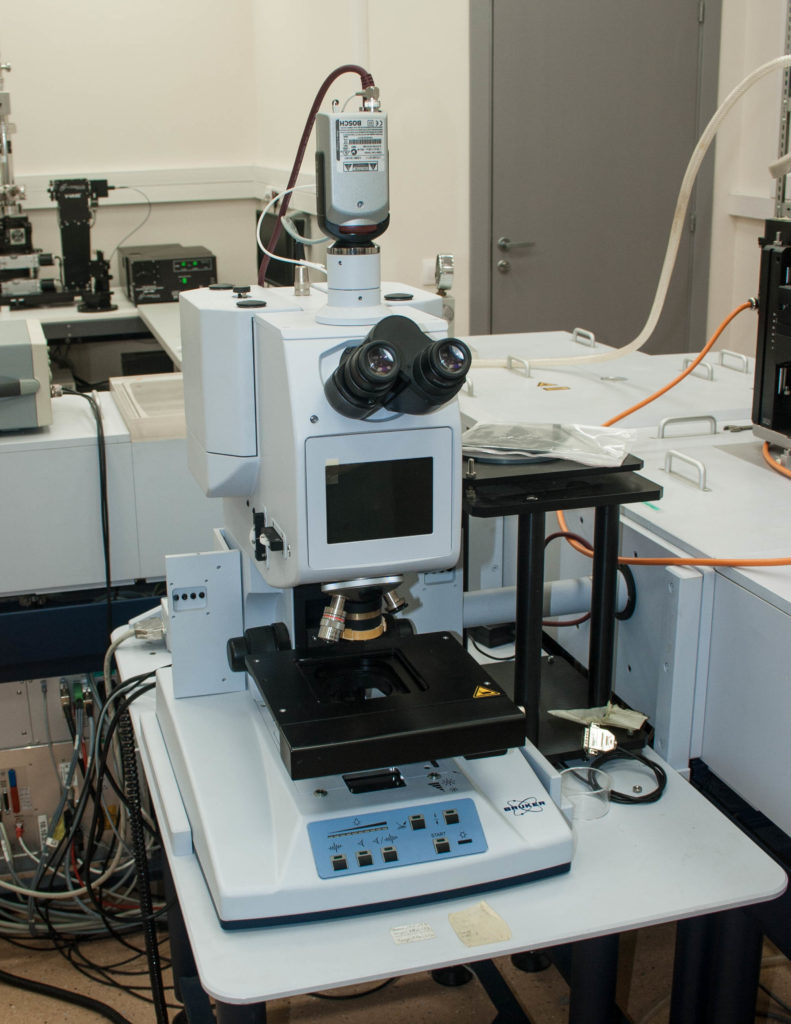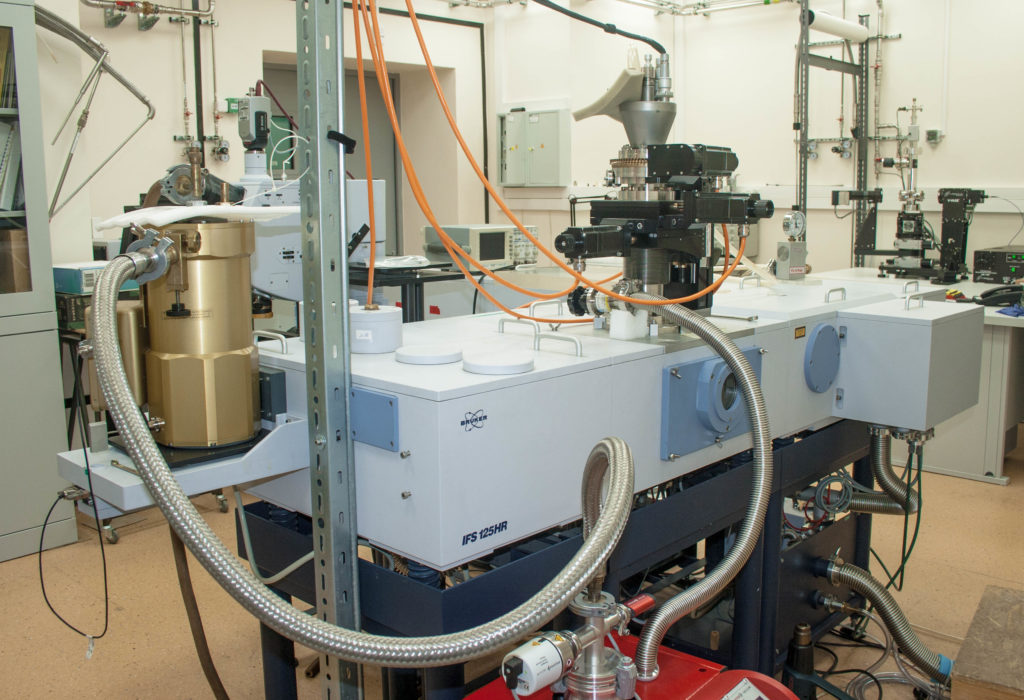Назначение:
Измерение спектров отражения и пропускания в спектральном диапазоне 10-10000 см-1 при температурах 4-300K.
Характеристики:
| Спектральный диапазон, см-1 (мкм) (Образец Ø 10мм) | 104-10 (1-1000) |
| Спектральный диапазон, см-1 (мкм) (Образец Ø 3мм) | 104-50 (1-200) |
| Максимальное спектральное разрешение, см-1 | 0.0063 |
| Разрешающая способность | лучше 106 |
| Абсолютная точность определения волнового числа: | ±5∙10-7∙ (абсолютное значение волнового числа) |
| Относительная точность определения волнового числа: | ±1∙10-7 |
| Фотометрическая точность | 0.1% пропускания |
| Скорость сканирования, см/с | 0.16-2.5 |
| Отношение сигнал/шум (peak-to-peak) при регистрации спектров поглощения, время накопления 5 с (разрешение 1 см -1), не менее | 1000 |
Прибор может быть укомплектован различными дополнительными приставками (несовместимы с криостатом):
- Измерение абсолютного значения отражения
- Измерение отражения с переменным углом падения
- Измерение абсолютного значения пропускания
- Измерение пропускания с 3х и 5-кратной фокусировкой
- Интегрирующая сфера для измерения отражения рассеивающих образцов
- Приставки одно- и многократного нарушенного полного внутреннего отражения.
Для низкотемпературных измерений спектрометр оборудован криостатом CryoVac KONTI Spectro A.
В криостате предусмотрена испарительная ячейка для напыления золота на образец (методика in situ Gold Evaporation) для высокоточных измерений спектров отражения незеркалых образцов
| Диапазон рабочих температур | 4.2 – 325К |
| Точность стабилизации температуры в диапазоне 4.2-100К | ±0.25К |
| Точность стабилизации температуры в диапазоне 100-325К | ±0.5К |
| Рабочий вакуум | 10-5 мбар |
| Диаметр окон (4 х 90º) | 40 мм |
| Диаметр свободной апертуры | 26 мм |
| Диаметр устанавливаемых образцов | от 2 до 13 мм |
| Диапазон перемещения образца по высоте (ось Z) | 50 мм |
| Диапазон перемещения образца по координатам X/Y | ±6 мм |
Для измерения микрообразцов спектрометр оборудован инфракрасным микроскопом Bruker Optics HYPERION 2000 с возможностью установки криостата.
| Спектральный диапазон | 500 – 7,500 см-1 |
| Оптимальная область измерения | 250 мкм |
| Минимальная область измерения | 20 мкм |
| Точность настройки положения в точке измерения | ± 1мкм |
| Диапазон температур | 15-300 К |



Основные направления исследований, проводимых с использованием установки:
- Измерение широкодиапазонных спектров отражения и пропускания;
- Определение широкодиапазонных спектров диэлектрической проницаемости и проводимости (совместно с результатами эллипсометрии);
- Определение свойств электронной и фононной подсистем исследуемого материала: величина щели полупроводника; резонансные частоты фононных колебаний; концентрация, параметры рассеяния носителей заряда, плазменная частота;
- Определение количества, величины и температурной зависимости сверхпроводящей щели и глубины проникновения магнитного поля для сверхпроводиников.
High Resolution Infrared Fourier-Spectrometer IFS 125 HR (Bruker)
IFS 125HR high-resolution Fourier-transform infrared spectrometer manufactured by Bruker Optik GmbH http://www. bruker.ru (FT spectrometer) is designed to measure optical spectra of transmission and reflection in infrared (IR) range, to determine concentrations of various organic and inorganic substances in solid and liquid phases, etc.

The FT spectrometer is based on the double-beam interferometer in which the displacement of an interferometric mirror results in the change in the path-length difference between the interfering beams. The spectrometer is set up as a Michelson interferometer with mirrors in the form of retroreflectors to reduce the influence of external factors. The detected light flux at the output of the interferometer as a function of the path-length difference (the interferogram) represents the Fourier transform of the detected optical spectrum. The spectrum (in the wave-number scale) is determined as a result of the special mathematical calculations (the inverse Fourier transform) of the interferogram.
The interferometer mirror moves linearly in time using the precision mechanism. The exact position of the mirror (the path-length difference in the interferometer) is determined using the reference channel. The zero value of the path-length difference (the main interferogram maximum) is determined from calculations. The FT spectrometer has a table-top design with a separate PC. The FT spectrometer represents a stationary automated device with the modular sealed optics. The sample chamber can be evacuated separately and blew down by air.
The device is equipped with a broad range of optional units and accessories including the 11o specular reflection/transmission unit, single reflection diamond attenuated total reflection (ATR) accessory, multiple ATR unit, parallel-beam transmission unit, integrating gold sphere to measure diffuse reflectance, unit for measuring absolute reflectivities etc. The FT spectrometer is equipped with the Optistat CFv cryostat by Oxford Instruments http://www.oxford-instruments.com with contact cooling and transport of refrigerant vapors. The cryostat allows one to control temperature of the sample under study within the range of 3.8-300 K with an accuracy of 0.1 K.

The measurement process is controlled using the internal controller and PC with the OPUS software. The OPUS software is the all-inclusive program package dedicated to the most efficient usage of the FT spectrometer capabilities. The choice of the sources, optical filters, sample channels and detectors is carried out from the OPUS software without disturbing vacuum in the spectrometer. The device setup, adjustment of its parameters, control of the device operation, Fourier transform of the interferogram, output information processing including the plotting of calibration charts against the reference substances, printing and storage of the analysis results are jumperless. The OPUS software also provides the exchange (transfer) of the data with other programs to prepare documents with the measurement results.
Samples with plane mirror-like surfaces 5-10 mm in diameter are most suitable for IR measurements. The samples for transmission experiments must possess small tapering or one rough surface to exclude interference effects.
| Spectral range | 11000 – 8 cm-1 0.9 – 1250 mm |
| Resolution | Better than 0.0063 cm-1 |
| Resolving power | Better than 106 |
| Wavenumber accuracy | Better than 5∙10-7 x wavenumber (absolute) 1∙10-7 (relative) |
| Photometric accuracy | 0.1% T |
| Aperture | f/6.5 |
| Scanner speeds | 0.16-2.5 cm/s |
Ответственные лица:
Муратов Андрей Викторович +7(499) 132-67-07; +7(499) 132-69-64; muratovav@lebedev.ru
Алещенко Юрий Анатольевич +7(499) 132-62-32; aleshchenkoya@lebedev.ru
